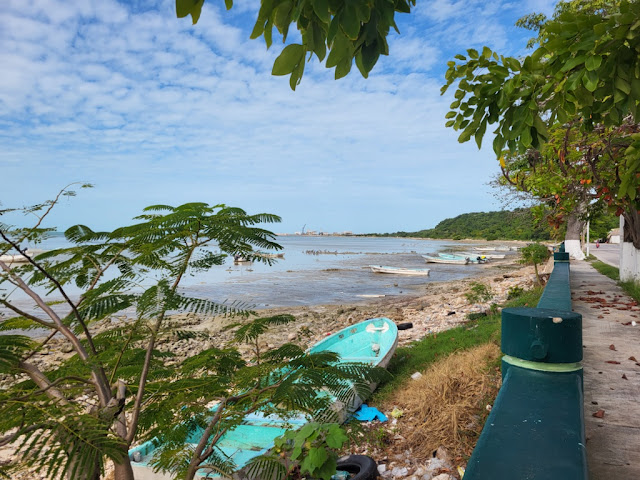It's the last morning of real holiday
time: soon we'll embark on the bus rides that will take us closer and
closer to the airport, interrupted for one more night in Valladolid
to break it up. Tonight we'll be in the same hotel where we spent
second night of our trip. Of course, since our bus rides have been an
essential part of the experience I suppose much can still happen.
Here we are in Seybaplaya, a small fishing village half an hour south of Campeche City. We had chosen this un-touristy place because we saw how close to the ocean it is on the way to Xpujil – ages ago, it seems now – and we really wanted to at least walk on a beach before we left.
The bus was to leave Villahermosa at a quarter to eleven on Monday, and the ride to Champotón, the town closest to Seybaplaya, was supposed to last about five hours, lots of time before the onset of darkness to find out about a way to get to our destination. Of course it didn't happen that way: we finally reached Champotón at seven pm! Luck was on our side, however: the connecting bus that would take us to Seybaplaya left twenty minutes later. I asked a fellow passenger to let me know where to get off, and as luck would have it, it was her stop as well. She proceded to take us all the way to the hotel, making sure we remembered the landmarks and corners, counted the blocks correctly, so that we'd find our way around the next day. We've encountered so much kindness here, and the interaction with the people are another important reason why this trip has been wonderful.
As I mentioned earlier this place is not one sought out by tourists. The centre of town, removed by one block from the malecón, the pier, is dominated by a plaza and a red church. Lots of little stores sell lots of things, a small supermarket - “Super Willy”, the kind we've encountered in other small towns – has much of what one might need, but there is no restaurant in sight, nor is there any place to sell beer. That happens along the malecón, though restaurants are rather sparse even there: as I said, this is a fishing village, not a tourist destination. Boats are docked all along the pier, hundreds of them, with names like Anna Maria, Josue, Camilla, Claudia, etc., often with a Roman number behind the name so that there might be three or even five with the same name, indicating, to me, that some owners must have several boats. That has to be the case, because there don't seem to be enough people here in this town for all the boats. We haven't been able to watch them when they came in with their catches, probably weren't near the pier at the right time, but whenever we walked by men were working on their nets.
I had read about a beach only about three kilometres from here called Payucán, popular especially during Holy Week before Easter. It sounded like we'd find beach restaurants there, maybe even hotels, and looking at Google Maps it was possible to get there on foot, walking along the pier for most of the way. That's what we decided to do yesterday morning: the beach, the ocean, were what we were here for, after all.
After several hundred metres the paved sidewalk ended and we continued on a dirt trail for a while, the ocean on one side, shrubs on the other. A couple of times a foul odour indicated another bag filled with remnants of fish had been dumped along the way, a cloud of flies rising from it. Garbage is still a huge problem everywhere, even though it seems to be collected in many places. Some effort is made to recycle in cities, but most often garbage, often in huge amounts, is just dumped by the side of the road.
A sign announced that we had reached Payucan, but there was no indication that this was anything like a beach resort. Palapas, the open huts covered with palm-frond roofs, lined the mostly rocky beach, but they looked dilapidated and abandoned, garbage and lanky weeds abounded here, too. I imagine that everything will be spruced up for local holiday times, but on this day the only person we saw was a man working with a weed whacker near the only hotel – also closed right now – at the end of the beach.
Johann went swimming for a while, and I just sat on a rock and enjoyed the sound of the small waves.
In the afternoon we headed into the opposite direction along the malecón in search of something to eat. I had found three restaurants along the pier online, and we checked them out, one by one, had planned to eat at the furthest one where my favourite, ceviche, was on the menu. The chicken and other meats that were also listed were not available, however, so Johann, not a seafood person, would have had to go hungry. Thus we just had a beer there and, as so often, the server brought a snack consisting of chips and – oh luck of lucks! - a plate of the very ceviche I craved.
We walked back to “Mario”, the smallest, least fancy restaurant, closest to our hotel, and ate a tasty dinner there, just before their closing time at 5:30 or six, right in time for the sunset.




















































